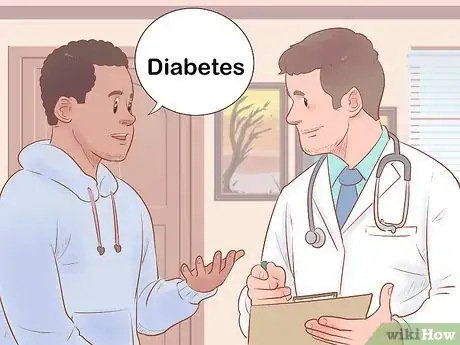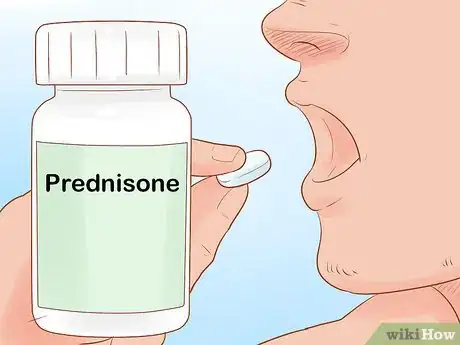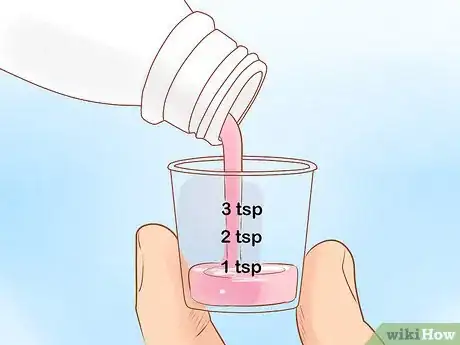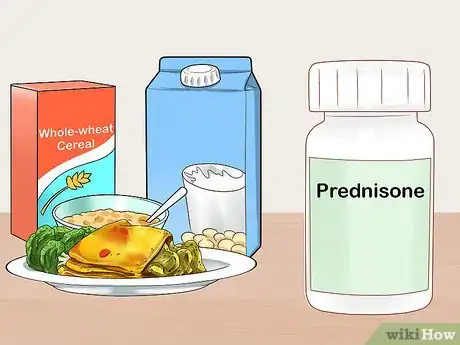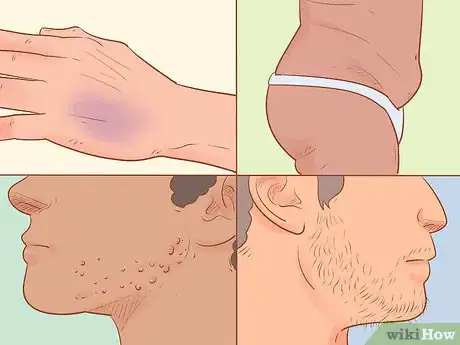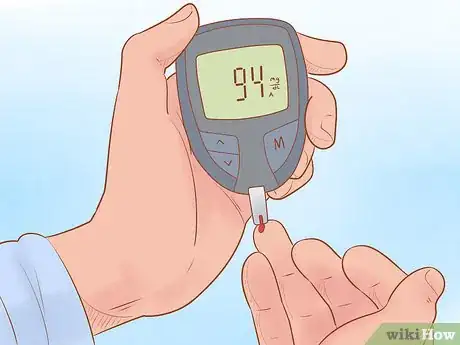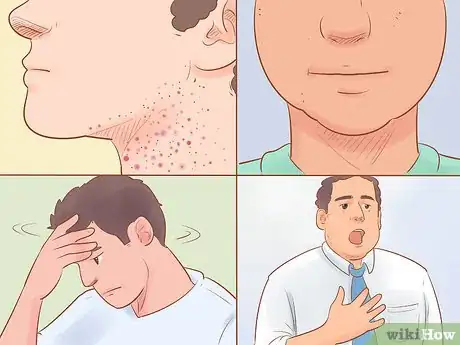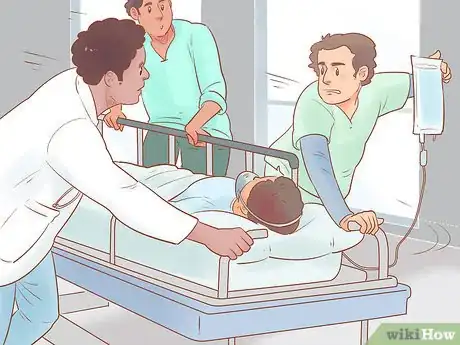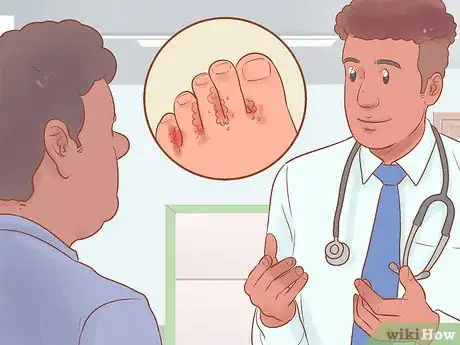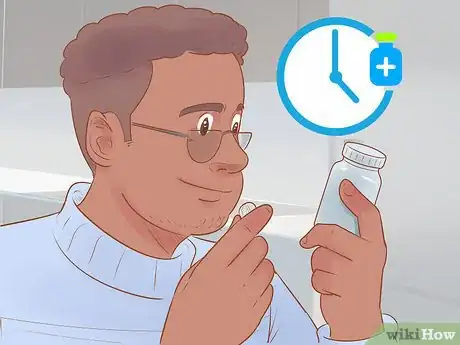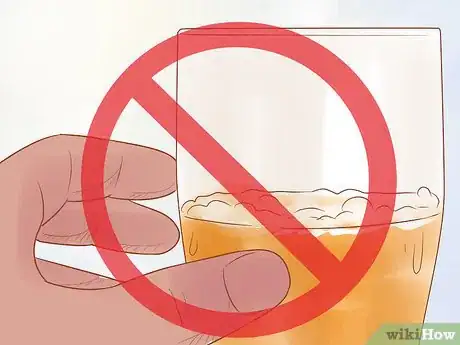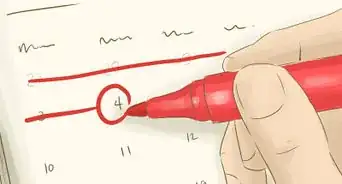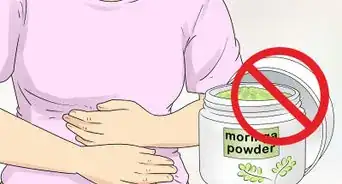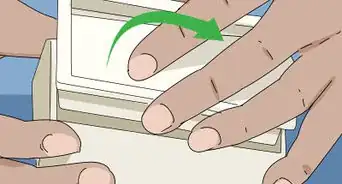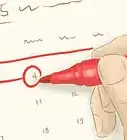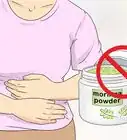This article was co-authored by Jurdy Dugdale, RN and by wikiHow staff writer, Jessica Gibson. Jurdy Dugdale is a Registered Nurse in Florida. She received her Nursing License from the Florida Board of Nursing in 1989.
There are 9 references cited in this article, which can be found at the bottom of the page.
This article has been viewed 23,212 times.
You've probably heard of the pharmaceutical steroid prednisone because it's used to treat a variety of medical conditions. If you've been diagnosed with an inflammatory condition such as allergies, arthritis, or lupus, your doctor may prescribe prednisone tablets or syrup. Because prednisone dosages vary considerably, it's important to follow your specific prescription. Recognize side effects and contact your doctor if you have any concerns or questions.
Steps
Taking Prednisone Under Medical Supervision
-
1Give your doctor a detailed medical history. When your doctor examines you to make a diagnosis, they'll ask you questions about your medical history. Because prednisone may weaken your immune system, it's important to let the doctor know if you've recently had or been diagnosed with:[1]
- Ulcers
- Diarrhea
- Liver, kidney, or heart disease
- High blood pressure
- Diabetes
- Depression
-
2Follow the doctor's dosing instructions. Once your doctor has diagnosed your condition and prescribed prednisone, talk with the doctor about how to take the medication. The doctor may start you on a higher dose of prednisone before dropping you down to a maintenance level dose. This might mean that you'll need to take prednisone several times throughout the day.[2]
- When prednisone is prescribed for short-term use to treat a temporary condition, it's usually taken for 5–10 days, with a different dosage each day.
- If you're taking prednisone long-term to treat a chronic condition, your doctor will likely start you at a higher dose to get your condition under control. Then, they'll gradually reduce the dose each day to completely wean you off of it or down to a lower dose for maintenance.
- Your doctor might need to change the dose if you experience stress from infection, fever, or an extreme illness. In some cases, they may lower the dosage, such as when you're recovering from an infection. However, they may increase your dosage if the condition they're treating with prednisone worsens.
Advertisement -
3Swallow prednisone pills if your doctor prescribed the tablets. Prednisone tablets are often enteric-coated so the medication is slowly released in your stomach. Though this isn't always the case, it's best to avoid crushing, chewing, or cutting the tablets before you swallow them.[3]
- Depending on your dosage, you may need to take just 1 or up to several tablets throughout the day.
-
4Measure prednisone solution if your doctor prescribed the syrup. Use the measuring cup or spoon that came with the medication and pour the prescribed amount. Take the prednisone once or several times throughout the day depending on your prescription.[4]
- If the medication doesn't come with a measuring cup or spoon, ask the pharmacist for one.
-
5Take prednisone immediately before or after eating. Although prednisone tablets are usually coated to make them easier to swallow, you shouldn't take them on an empty stomach. The food will line your stomach which can reduce irritation so eat right before or after you plan on taking the prednisone.[5]
Recognizing Side Effects
-
1Learn about common side effects. The longer you take prednisone and the larger the dose, the more likely you are to experience side effects. You might notice thinning skin that bruises easily, redistribution of body fat, acne, and increased facial hair.[6]
- Most side effects of prednisone are caused by long-term use, particularly changes in weight or skin thinning. If you're using it as a short-term treatment, you likely won't have any major side effects if you aren't allergic to the drug.
- Some people report impotence and menstrual problems after being on prednisone for a while.
-
2Monitor your blood sugar if you've ever been diagnosed with diabetes. If you've been diagnosed with latent diabetes and aren't on insulin or you're managing your insulin levels, be aware that prednisone can interfere with your diabetes medications to make them less effective.[7]
- You may need to begin insulin or increase your medication dosages to manage your diabetes.
-
3Look for skin or breathing changes if you have an allergic reaction. Although it's unlikely that you develop an allergic reaction to prednisone, recognize the signs of a reaction. If you're going to have an allergic reaction, it'll happen when you start taking it, such as within your first few doses. If you think you're having an allergic reaction, contact your doctor and tell them you're experiencing 1 or more of these symptoms:[8]
- Rash
- Itching or swelling (especially around your face or throat)
- Severe dizziness
- Difficulty breathing
-
4Get immediate medical attention if you have severe side effects. Although it's rare, prednisone can cause extreme stomach pain, bloody or black stools, extreme depression, behavioral changes, and vision problems. If you experience any of these severe side effects, get emergency medical attention.[9]
Using Prednisone Safely
-
1Talk with your doctor if you're pregnant or breastfeeding. Studies suggest that taking prednisone during pregnancy can increase the risk of birth defects, though the risk is highest in the first trimester, and cause low birth weight. Let your doctor know if you become pregnant while taking prednisone. You should also avoid taking prednisone if you're breastfeeding because the medication is transferred to breast milk.[10]
- If your doctor believes that prednisone is essential to your treatment, they may put you on the lowest dose. If you're breastfeeding, the doctor might have you wait 4 hours after taking the medication before you feed your baby. However, this may not be necessary, so talk to your doctor.
-
2Talk to your doctor if you get a fungal infection. If you have a fungal infection, it's important to tell your doctor. They may not prescribe prednisone because it may weaken your immune system and make it harder to fight the infection. Your doctor will determine if you need to avoid taking prednisone until the infection clears.[11]
- This may not be an issue if you're taking a low dosage of prednisone. However, it's best to talk to your doctor.
- If you develop a fungal infection after you've started taking prednisone, tell your doctor immediately. They may advise you to temporarily stop taking prednisone.
-
3Take a missed dose as soon as you remember. If you've forgotten to take 1 of your daily prednisone doses, don't double up on the medication when you remember. Instead, take the regular amount as soon as you remember.[12]
- If you remember just before it's almost time to take another scheduled dose, just take the upcoming dose without doubling up.
- Don't stop taking prednisone completely. When you're ready to stop the medication, the doctor will gradually reduce your dosage.
-
4Contact poison control or emergency services if you overdose. If you've taken more than the recommended dosage, call the poison helpline (1-800-222-1222) or emergency services.[13] This is especially important if you experience:[14]
- Trembling and convulsions
- Elevated blood pressure
- Fever
- Heart attack or stroke
-
5Avoid drinking alcohol while you're taking prednisone. Because alcohol and prednisone affect people differently, doctors recommend not drinking while taking the medication.[15]
- Alcohol and prednisone may increase your risk for gastrointestinal bleeding and ulcers.
Warnings
- Always keep prednisone out of the reach of children.⧼thumbs_response⧽
References
- ↑ https://www.drugs.com/prednisone.html
- ↑ https://www.drugs.com/dosage/prednisone.html
- ↑ https://medlineplus.gov/druginfo/meds/a601102.html
- ↑ https://www.drugs.com/prednisone.html
- ↑ https://patient.info/medicine/prednisolone-deltacortril-deltastab-dilacort-pevanti
- ↑ https://www.hopkinsvasculitis.org/vasculitis-treatments/prednisone/
- ↑ https://www.kidney.org/content/what-you-need-know-about-prednisone
- ↑ https://medlineplus.gov/druginfo/meds/a601102.html
- ↑ https://medlineplus.gov/druginfo/meds/a601102.html
About This Article
If your doctor has told you to take prednisone, make sure to follow the prescription instructions closely, as they may start you on a higher dose before dropping you down to a maintenance level dose. To take prednisone in pill form, avoid crushing, chewing, or cutting the tablets since that might affect how it is absorbed in your stomach. Also, take your tablet immediately before or after eating to reduce any stomach irritation. If you forget to take a dose, take it as soon as you remember instead of doubling up next time you eat. While prednisone has common side effects like bruising, acne, and increased facial hair, get immediate medical attention if you have rarer side effects like stomach pain, bloody or black stool, extreme depression, and vision problems. For more help from our Medical co-author, like how to recognize an allergic reaction to prednisone, scroll down.
